Evolution of Rapid Technologies
The rapid movement is now characterized by a move to rapid manufacturing of end-use parts and the evolution of 3D printing to the desktop.
Latest News
December 1, 2010
By Susan Smith
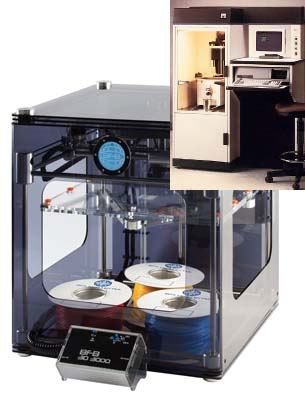 3D Systems’ first additive manufacturing system (inset) and a low-cost 3D printer from Bits from Bytes, which 3D Systems recently acquired. |
The promise of rapid technologies is obvious: instant, affordable prototyping. The evolution of rapid technology is characterized by rapid growth, and a definite asset to manufacturing, promising to move beyond prototyping to actual finished, manufactured parts in some cases. But where has it come from, and where is it going? How long will it be before there is a 3D printer on every engineer’s desktop?
Rapid Technologies, Then and Now
Originally, rapid prototyping was developed to give manufacturers a way to test out parts or prototypes before embarking on the costly process of manufacture. In the beginning, the parts were not designed for actual manufacture, but now some high-end companies offer processes that can actually produce manufactured parts—thus the “rapid manufacturing” term was coined to encompass this new direction.
The first rapid prototyping company, 3D Systems, developed stereolithography (SLA) in 1986. This was followed by the invention of the .stl file format, spearheaded by Charles Hull, who is still chief technology officer and executive vice president at 3D Systems.
Brian Ford, director of strategic marketing for Quickparts, notes that when the technology was first introduced, materials were very brittle, not visually appealing, and generally had a rough finish. SLA materials were amber-colored, and would yellow and age over a short period of time.
The first machines were large, unreliable, expensive and required dedicated operators. Bruce Bradshaw, director of marketing for Objet North America, says the industry started in the back room—with messy processes and big open vats of carcinogenic liquids. Today, most vendors offer machines that fit in an office environment and are environmentally safe to use there.
According to Cathy Lewis, vice president, global marketing for 3D Systems Corp., while system size varies from small footprint to extra-large, high-productivity platforms, these units are easy to operate, provide long, unattended operation and are reliable.
“The additive manufacturing systems today also offer a wide material portfolio, high-definition capabilities, efficiency and can handle far more complex geometries,” says Lewis. “The two most notable changes are the move to rapid manufacturing of end-use parts and the evolution of 3D printing, where almost any size business or educational institution—or even an individual—can afford to invest in their own 3D printer for in-home or in-office use.”
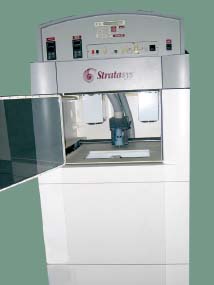 Stratasys’ first commercial machine, the “3D Modeler,” was introduced in 1991. |
Stratasys’ Joe Hiemenz says the Stratasys fused deposition modeling (FDM) process became known for its ability to make acrylonitrile butadiene styrene (ABS) parts suitable for functional testing.
“In the early years, our accuracy wasn’t as good,” he admits. “Over the years we’ve added several varieties of thermoplastics, such as polycarbonate, ]polyphenylsulfone, or PPSF], and Ultem, as well as industry-specific formulations, such as ISO versions for medical use. And some of our systems now rival injection molding by producing highly toleranced parts with accuracies as high as 0.003 inch.”
Today, Stratasys has a robust quality control system in place and is in the process of ISO Certification.
“Our raw components, subassemblies and finished products go through stringent performance testing, so we’re confident when we ship product,” Hiemenz says. “Our high-end product lines that are used for production have each had exhaustive studies on output repeatability, showing that part-to-part, their output is on par with injection molding.”
That kind of performance wasn’t always there. In the early years, additive system manufacturers may have introduced products a little faster than they should have. The technology was new, and there was a strong demand from major industries like aerospace and automotive that saw an advantage that competitors didn’t have.
“Stratasys learned our lesson with an early model of a 3D printer called the Genisys, which launched before it was a whole product,” says Hiemenz. “It was a multi-million dollar lesson in making sure your product is ready before you launch.”
Z Corp.’s vice president of product management, Joe Titlow, says the company’s first machine was the ZCorp 402, introduced in 1996. At the time, it did not have color, and it was much more expensive. It was also very complex and not nearly as reliable as the company’s current products.
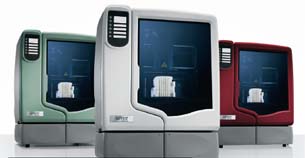 The modern uPrint from Stratasys Dimension 3D Printing is compact enough to fit on the desktop, inexpensive and easy to use. |
“Overall, every dimension that is meaningful to a customer has improved since then,” says Titlow. “Cost of machine and operations has gotten better. The machines have become much easier to use, and overall, materials have improved significantly in terms of their accuracy and material properties. The improvements in color performance have been very dramatic since our first color 3D printer came out in 2000. It helps to make them less expensive and easier to use, but the key is really trying to simplify the technology and make it more robust.”
Some of the most important changes are reliability and repeatability, according to Hiemenz.
“Most additive system makers are no longer content with just prototyping,” he adds. “Many are pursuing the production industry. The requirements are more stringent, and system makers have stepped up their quality efforts.”
Materials research continues to be an important area of ongoing R&D, and investment for rapid manufacturing companies will continue to grow in rapid manufacturing and medical applications. Materials are currently available in a range of colors and consistencies. There are brittle, delicate materials, very strong materials and those that are designed to be used as actual parts. The vulnerability to temperature, moisture and general exposure in materials has lessened over the years, but new stronger, more resilient materials are constantly being developed. There is a lot more to choose from today, and advantages with each rapid manufacturing process.
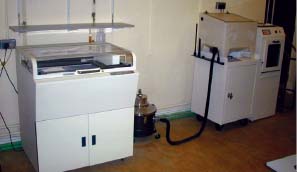 Z Corp. debuted its first machine, the ZCorp 402, in 1996. |
According to Lewis, today the materials offered by 3D Systems have grown from a single resin that was quite brittle to “a full complement of robust plastic materials, to almost indestructible powders used in our selective laser sintering ]SLS] process and metals resulting from selective laser melting ]SLM].”
Two Major Trends
Two major trends characterize the growth in rapid manufacturing:
1. In the low-price, 3D printer market, there is a continuing trend of prices coming down, while quality goes up. Even better, the market grows larger as the price comes down. Rapid technology manufacturers are approaching this potential in different ways.
“Our agreement to be an OEM for Hewlett-Packard 3D printers tells you they believe there’s a growing market for 3D printers at the right price,” Hiemenz reports.
“We are currently seeing substantial growth in rapid manufacturing applications as the systems and materials have matured,” says Lewis. “These applications range from industrial to medical and all manner of artistic endeavors.”
Lewis notes that because of this growth, 3D Systems has recently acquired one of the early 3D printer kit companies, Bits from Bytes, to address the low-end 3D printer market that may want the technology for small prototyping operations or for art or hobbies.
“At price points well below $5,000, with the benefit of lower-cost materials, we believe there will be an explosion in 3D printer adoption over the next few years,” he adds.
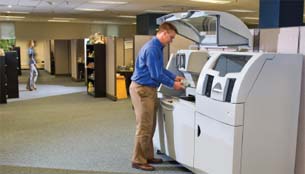 Z Corp.’s highest-resolution, largest build size, premium-color 3D printer: the ZPrinter 650. |
Z Corp. has also come out with two low-cost machines in the last year: the Z150 and Z250. The company has incorporated the same ease of use of its higher-end machines into these units.
Bradshaw of Objet North America said they will move into the volume space at the low end of the market, with their Alaris low-cost machine, for customers who may buy several small desktop printers to do early prototyping before getting to more complex prototyping.
“The high-volume market is really matching the 2D printing space, where the value proposition of the printer grew with inkjet technology followed by low cost laser technology,” Bradshaw adds.
2. At the other end of the spectrum, more manufacturers are moving to additive systems for low-volume production needs. They’re opting for “3D production systems,” such as those produced by Stratasys and laser-sintering systems from EOS.
Reverse Technologies Joe Titlow, Z Corp.’s vice president of product management, says his company sees reverse engineering as an interesting adjacent market not core to 3D printing. Although Z Corp. “benefits significantly” from having the ZScanner line in its portfolio, Titlow says, “the target application is sometimes overlapping. I separate it from rapid prototyping. It’s another way to gather the 3D information you need. It is at the front of the process that the customer goes through to get something that they want to print.” |
“Additive systems will probably never compete with traditional processes for high-volume production, but for low-volume, the additive process is ideal,” says Hiemenz. “Direct digital manufacturing ]DDM] brings enormous cost reduction and lead time reduction.”
And if you think your operation doesn’t need low-volume production because you’re a mass producer, he adds, think again: “You probably use hundreds of custom assembly tools that are produced in low volume. There’s loads of money waiting to be saved in this area.”
Dr. Hans J. Langer, a pioneer of commercial laser sintering and CEO of EOS GmbH, agrees.
“In the coming years, additive manufacturing will see even greater integration into the manufacturing environment,” he says. “Finely tuned quality assurance and standards for materials, processes and production parameters will continue to emerge. So will industry-specific standards. These advances will be driven by the desire of OEMs and their suppliers for cost reduction, increased productivity and complete design freedom that technologies like laser-sintering offer.”
The demand for lower-cost machines, greater accuracy, better material properties, color, standards and other criteria to meet the design-to-manufacture process continues to drive the industry.
More Info:
3D Systems
Dimension Printing
EOS
Objet Geometries, Ltd.
Quickparts
Stratasys
Wohlers Associates
Z Corporation
Susan Smith has been working as an editor and writer in the technology industry for more than 16 years. She is a contributing editor for DE. She can be reached via [email protected].
Subscribe to our FREE magazine, FREE email newsletters or both!
Latest News
About the Author
DE’s editors contribute news and new product announcements to Digital Engineering.
Press releases may be sent to them via [email protected].






